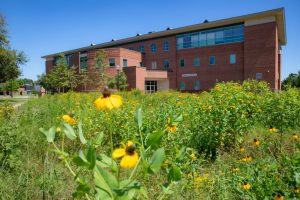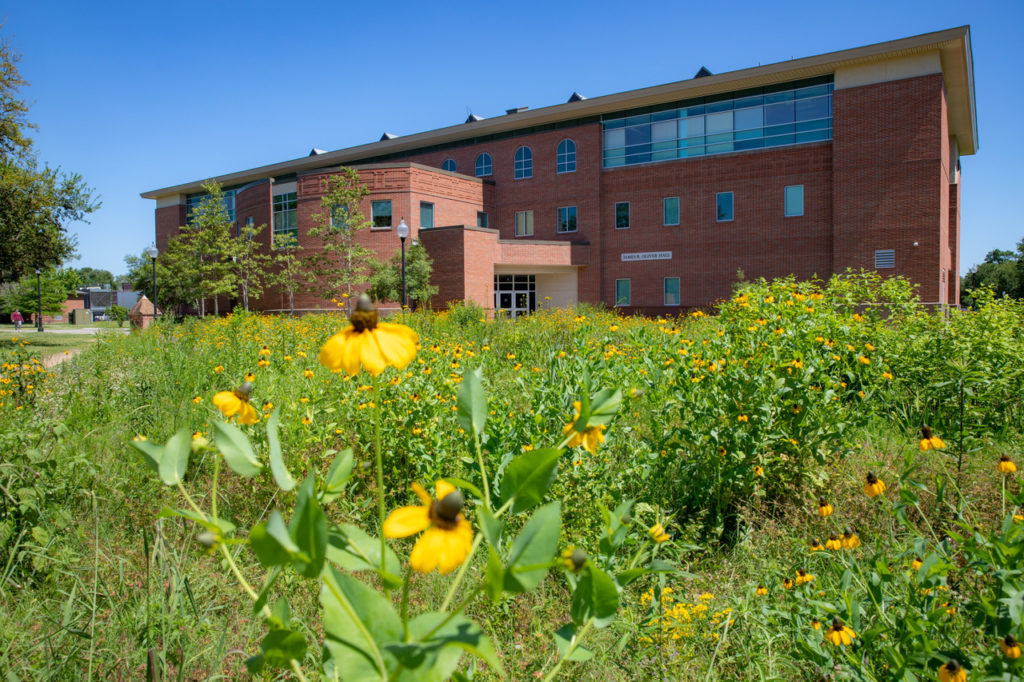On April 23, the U.S. Environmental Protection Agency (EPA) announced the winners of its 7th annual Campus RainWorks Challenge. The competition tasks college students and faculty nationwide with designing innovative, on-campus stormwater management features. These features need to demonstrate how green infrastructure can mitigate runoff pollution, reduce local flooding, and create new amenities that enhance the student experience.

The U.S. Environmental Protection Agency’s (EPA) annual Campus RainWorks Challenge calls on college students to work as teams to advance stormwater management on campus. EPA announced in April that student teams from the University of Oregon and the University of Louisiana at Lafayette won first-place for this year’s competition in the Demonstration Project and Master Plan categories, respectively. Rachel Keyes/University of Louisiana at Lafayette.
Interdisciplinary student teams, assisted by at least one faculty member, submitted entries to EPA at the end of 2018 for either the Demonstration Project or Master Plan category. Demonstration Project entries design and construct proof-of-concept-level green infrastructure interventions for specific areas of campus, whereas Master Plan entries propose conceptual designs that implement green infrastructure throughout areas of at least 6 ha (15 ac).
First-place winners in each category receive a student prize of $2,000 and a faculty prize of $3,000, to be spent in support of green infrastructure research and education. Second-place student teams split a $1,000 prize and faculty advisors receive $2,000, according to an EPA release. 49 colleges and universities participated in this year’s challenge.
Demonstration Project category
In the Demonstration Project category, teams from the University of Oregon (Eugene) and the University of Arizona (Tucson) won first and second place, respectively.
The University of Oregon project focused on the campus of nearby South Eugene High School, located along the banks of Amazon Creek. The creek flows into the Columbia River before eventually reaching the Pacific Ocean. The team realized the campus’ large lawns, which remain vacant and unused for most of the year, offered an opportunity to demonstrate the benefits of green infrastructure without having to dig into concrete.
“The soils there are really waterlogged, the water table is very close to the surface, and so those spaces go completely underutilized,” said Evan Elderbrock, team member and PhD student at the University of Oregon, in a video describing the University of Oregon project. “Our primary design interventions look to reduce the pollutant loads in the urban stormwater that’s running into Amazon Creek while also stacking benefits.”
The project team installed a host of demonstration-scale green infrastructure interventions, all with educational signage, including
- rain gardens that filter stormwater from 0.6 ha (1.5 ac) of lawn and more than 1.6 ha (4 ac) of impervious surface, containing over 24,000 new plants;
- approximately 929 m2 (10,000 ft2) of porous asphalt to replace 26 impervious parking spaces, including additional planters that filter runoff from the lot;
- 51 new native trees that intercept precipitation, sequester carbon, and reduce air pollution, nearly doubling the total number of trees on campus; and
- a new bicycle parking area covered by a 170-m2 (1800-ft2) green roof.
The University of Arizona campus houses more than 250 surface-level parking lots, all of which are impervious, and 95% of which have no tree canopy cover to intercept precipitation, according to the project team’s video. At a large, centralized lot frequented by both commuters and pedestrians, students installed basins and bioswales capable of retaining nearly 87,000 L (23,000 gal) of stormwater.
They also retrofitted existing pedestrian walkways with new trees and wayfinding signage, adding about 243 m2 (2,619 ft2) of canopy cover. While discouraging heat island effects and improving stormwater retention rates, the design also provides additional safety for pedestrians by creating a natural barrier between walkways and the parking lot.
The team worked closely with University of Arizona researchers to include sensors in each of their interventions to gauge their effectiveness over time, with the hope of identifying best green infrastructure practices for the campus’ arid climate, according to an EPA release.
Master Plan category
Students from the University of Louisiana at Lafayette (ULL) won first place in the Master Plan category for their proposal to redesign about 217 ha (536 ac) of low-lying, flood-prone space on and near campus.
For three days in August 2016, the area around campus received 31 to 36 cm (12 to 14 in.) of rain during a severe storm, causing catastrophic flooding. With most of the region covered by impervious space and served by gray infrastructure, the project team saw an opportunity to improve stormwater management by experimenting with green infrastructure.
“Since the August 2016 flood, the community’s eyes have opened to the city’s stormwater management issues and community members have been looking to the university for answers,” said architecture student and team member Lauren Lambert in a video. “Our team believes it is our responsibility to propose a responsible paradigm for green infrastructure implementation that can be applied to both new and existing development across rural and urban contexts.”
The team proposed planting prairie grass as buffer strips along edges of existing gray stormwater conveyance systems, adding a host of rain gardens and bioswales throughout campus, installing permeable pavement on crosswalks, sidewalks, and in parking lots. They also proposed an aquifer storage and recovery well, which collects and treats excess stormwater during heavy storms before injecting it into groundwater supplies for later withdrawal.
Earning second place, students from Florida International University (FIU; Miami) proposed creating 11 artificial wetlands around campus alongside existing lakes, connected by remotely operated and programmable siphoning systems. Campus stormwater managers would use a computer-based decision-support tool developed by the project team to maximize runoff storage capacity and minimize flooding during heavy precipitation events, according to the team’s submission video.
Based on renderings from the team’s decision support tool, they predict the wetland network would remove
- 56% of biochemical oxygen demand;
- 79% of total suspended solids;
- up to 100% of total nitrogen and phosphorus; and
- over 99% of fecal coliforms.
“This project exemplifies the creativity and innovativeness we are cultivating here at FIU,” said John Volakis, dean of the FIU College of Engineering and Computing, in a press release. “In this case, our civil engineering students introduced a design that incorporates green infrastructure elements. As a college, we couldn’t be more proud of their achievements.”





